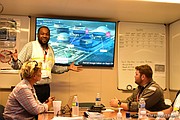Friday, September 27, 2019
By DENISE MAYCOCK
Tribune Freeport Reporter
dmaycock@tribunemedia.net
Approximately 12,000 barrels of oil and water have been recovered to date by clean-up crews in response to the oil spill incident triggered by Hurricane Dorian at the Equinor South Riding Point facility in East Grand Bahama.
There are 13 vacuum trucks and a team of 250 responders from both international and local response organizations on the ground there now, company officials told reporters on Friday during a tour.
Before the storm, the terminal had 1.8 million barrels of crude oil stored.
The dome-shaped lids of two storage tanks – numbers six and ten – at the facility were blown off, and oil was dispersed in the area as Hurricane Dorian unleashed 185mph winds and pummeled the island for about 40 hours.
At a media briefing onsite three weeks after the disaster, Equinor operation manager Kevin Stuart admits that they still do not know how much of the 1.8 million barrels was spilled, or the exact size and percent coverage of the land area was affected.
However, he was confident that there was no spill to the ocean and that the spill occurred onshore, just north of their facility.
The event is being called “the worst disaster” ever in the company’s history.
The Equinor’s oil-stained Administrative Building is no longer able to accommodate its 54 employees, who have been relocated to the Pelican Bay Resort at Port Lucaya.
“We have a situation in front of us; I call it an act of God – we have a spill – and we want to clean it up safely,” Mr Stuart said at their command centre, located on board one of the mega response vessels docked at its terminal, equipped with heli-pad and a 16-seater helicopter.
Mr Stuart reported that only three tanks contained crude oil. Storage tank number 8, which was not compromised, contained 410,178.91 barrels of oil. The two damaged storage tanks, number six contained 729,681.08 barrels and number eight contained 730,707.01 barrels.
“Right now, we cannot speak to volumes that was spilled because we just do not know. Two tanks damaged by tornadic activity, we cannot safely assess them to get volumes.
“We had 1.8 million barrels of product at the facility, and of the three tanks that contained oil, only two were compromised,” he explained. So, obviously, there was a spill, but for me to see they are saying 1.8 million barrels was spilled, I can’t quantify it. I can only show you the facts. We cannot give out figures, but you can see 1.8 million barrels can’t be what was spilled,” said Mr Stuart.
On our arrival at the facility, the top layer of the oil-soaked ground in the immediate area had been scraped up into a pile, and men in bright green florescence vests and suits were busy with clean up and monitoring on the ground.
A Wildlife Response Unit was set up on the compound where a wildlife response expert reported that they were tending to two birds that were affected by the spill. The team is still trying to locate and capture five other birds and a goat that were also affected by the spill.
A team of expert responders gave a brief update of their findings at the site.
They are only detecting “low levels of VOCs” (volatile organic compounds). No btex compounds - benzene, toluene, ethyl, or xylene, have been detected, according to an expert responder at the facility.
“We are not seeing any actionable levels; we are monitoring inside the containment berms of the tanks and the roadway, GB Highway from check point to check point, said the responder.
“It is real time monitoring with instruments. We have constant monitoring via ProRae Guardian network system so we are able to see real time every 15 seconds VOCs, LEL, H2S (Hydrogen Sulfide); so we are seeing very favorable data regarding no exposure for the response thus far.”
Dr Oloff indicated that the substances they were most concerned about are benzene and volatile hydrocarbons.
“The good thing about the warm weather and the wind is that it tends to evaporate and disappears quickly so the measurements we have done show very favourable outcome,” he reported.
He also said that they have not seen any actionable levels to require respiration protection at this point.
The company has contracted two independent assessment firms – Polaris and Oil Spill Responders Ltd.
The media was also taken on an aerial tour by helicopter of the facility to view the damage at the facility, and the affected areas.
